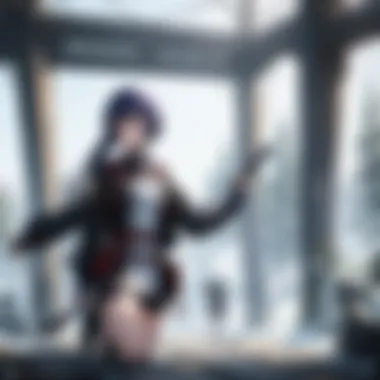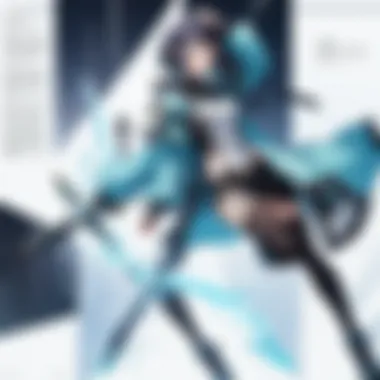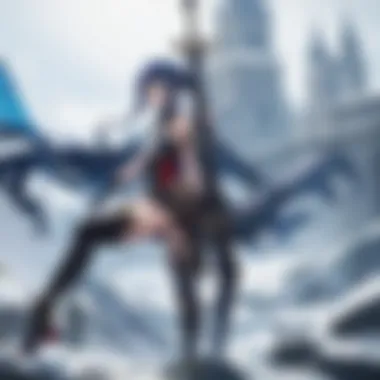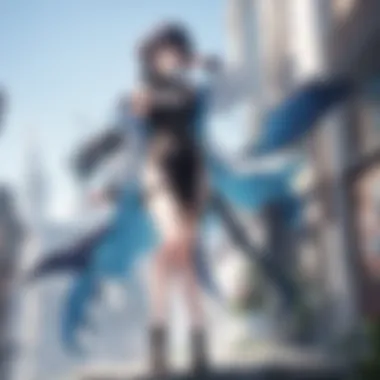MMOs Similar to Sword Art Online: An In-Depth Exploration


Intro
The impact of Sword Art Online within the anime and gaming community cannot be overstated. Its narrative complexity and innovative approach to virtual realities have not only captivated audiences but also influenced the design and structure of several massively multiplayer online games (MMOs). In this exploration, we aim to delve into those MMOs that share thematic and gameplay similarities with Sword Art Online, discussing how these games reflect the ambitions and challenges illustrated in the series.
Understanding these connections is essential for anime enthusiasts, gamers, and those interested in virtual worlds. By examining character profiles, themes, popular series, and recommendations, we offer deeper insights into why players are drawn to these immersive experiences and how they parallel the rich storytelling found in Sword Art Online.
Character Profiles
Overview of Main Characters
At the heart of many MMOs that resemble Sword Art Online are characters that embody the struggles and perseverance seen in Kirito, Asuna, and others. These main characters often serve as avatars for players, reflecting high-stakes conflict and emotional depth.
Take, for instance, Genshin Impact. The protagonist, Aether, embarks on an epic journey in a vast open world, confronting formidable foes and uncovering mysteries. His adventures mirror Kirito's quest for truth and connection within the digital realm. Similarly, Asuna's representation of strength and companionship resonates through characters found in other MMOs, such as Final Fantasy XIV's Warrior of Light, showcasing the importance of cooperation in overcoming obstacles.
Supporting Characters
Supporting characters in these games often enrich the narrative and gameplay experience. In The Elder Scrolls Online, figures like Aerin and Lyris Titanborn reinforce themes of friendship and loyalty. Such character dynamics parallel those in Sword Art Online, where relationships lend emotional weight to the story.
Moreover, the synergy between main and supporting characters allows players to feel invested in the story's outcome, nurturing a sense of community much like that seen in the fandom surrounding Sword Art Online.
Theme Exploration
Central Themes
Themes of reality versus fantasy are central in both Sword Art Online and its associated MMOs. Players navigate digital landscapes where the stakes are often life and death, paralleling the game mechanics and narrative arcs found in these worlds. The exploration of identity also stands as a prominent theme. Characters often grapple with their real selves versus their avatars, inviting players to reflect on their own experiences within the gaming ecosystem.
Cultural References
Various MMOs incorporate cultural elements that resonate with the themes from Sword Art Online. For instance, World of Warcraft integrates lore drawn from mythology and history, inviting players to engage with a rich tapestry of narratives. This blend mirrors the cultural discussions presented in Sword Art Online, making immersive gameplay a shared journey that extends beyond personal experiences.
Popular Series and Recommendations
Top Anime Series of the Year
For fans of Sword Art Online, there are several anime series that align well with its themes:
- Re: Zero - Starting Life in Another World
- Log Horizon
- No Game No Life
These titles not only share thematic elements but also expand upon the idea of games as a central narrative device, much like in Sword Art Online.
Hidden Gems in Manga
In exploring manga that reflect similar themes, consider:
- Sword Art Online: Progressive
- Overlord
- The King's Avatar
These selections offer fascinating narratives and character development, enriching the experience for fans who appreciate complex storytelling.
The intersection of gaming and narrative in MMOs offers a lens through which players can explore their identities and expand their horizons.
Through this exploration of character profiles, themes, and recommendations, we aim to unveil the depth of MMOs that reflect the essence of Sword Art Online, providing valuable connections for players and fans alike.
Foreword to MMOs and Sword Art Online
The realm of massively multiplayer online games (MMOs) has grown in complexity and popularity over recent years. MMOs create unique environments that allow players from various backgrounds to immerse themselves in rich virtual worlds. These games often draw inspiration from various sources, including anime, such as Sword Art Online. Understanding the intersection between MMOs and Sword Art Online is crucial for grasping how these games have evolved and influenced one another.


This article will explore how MMOs can mirror the themes of Sword Art Online, providing insights into the characteristics that define both the genre and the series. We will delve into the aspects that make these games appealing to players, as well as the significant factors that developers consider while creating them. By analyzing their features, narratives, and community dynamics, we aim to illustrate how MMOs resonate with an audience that appreciates both gaming and anime.
Understanding MMOs
Massively multiplayer online games allow large numbers of players to interact within a shared online environment. MMOs can be categorized into various types, including role-playing games (RPGs), first-person shooters, and strategy games. Each type offers different experiences, yet they often include certain hallmark features, such as expansive worlds, quests, and player collaboration.
The primary attraction of MMOs lies in their social aspects. Players can form teams, compete against one another, or collaborate to complete challenging tasks. These interactions build a sense of community, which is often highlighted in games like World of Warcraft and Final Fantasy XIV. Additionally, MMOs frequently provide opportunities for personalization, allowing players to create and develop their characters in unique ways. This makes the gameplay experience richer and more engaging.
In recent years, advancements in technology have further enhanced the MMO experience. The implementation of improved graphics, sophisticated AI, and large-scale environments has resulted in immersive gameplay that feels more lifelike than ever.
The Influence of Sword Art Online
Sword Art Online has had a profound effect on the gaming landscape. The series portrays a virtual reality MMORPG where players become trapped, emphasizing themes of survival, identity, and reality's complexity. This narrative approach has inspired many game developers to integrate similar elements into their MMOs.
The influence of Sword Art Online can be observed in various aspects of game design:
- Narrative Depth: Many MMOs now incorporate intricate storylines that draw players into their worlds, reminiscent of the engrossing plots found in Sword Art Online.
- Realistic Virtual Environments: Enhanced graphics and VR capabilities have allowed developers to create immersive environments that echo the series.
- Character Interaction: Games increasingly allow for deeper character relationships and interactions, fostering emotional connections akin to those seen among characters in the anime.
"The impact of Sword Art Online on modern MMOs cannot be understated; it has shaped the way narratives are woven into gameplay, creating a more immersive and engaging experience for players."
This influence has paved the way for a generation of gamers who expect more from their virtual experiences, emphasizing narrative-driven gameplay and community interaction. As we continue to explore the characteristics of MMOs that reflect Sword Art Online, it becomes evident that the game development landscape is continually evolving to meet these expectations.
Characteristics of MMOs Similar to Sword Art Online
The realm of massively multiplayer online games (MMOs) has evolved significantly, showcasing a variety of game mechanics, narratives, and social dynamics. When discussing characteristics specifically akin to Sword Art Online, it becomes essential to identify elements that resonate with players seeking similar experiences. Understanding these characteristics enables enthusiasts to navigate through myriad options to find games that truly capture essence reminiscent of this popular series.
Immersive Virtual Worlds
Immersion in virtual environments is one of the core hallmarks of MMOs. Games that mirror the experience found in Sword Art Online often present expansive landscapes teeming with detail. These worlds are not merely background settings; they are dynamic ecosystems where players can strategize, explore, and interact with the environment.
Notable features include day-night cycles, diverse biomes, and intricate lore embedded within the game’s universe. Players experience a sense of realism and agency as they traverse these worlds. For instance, both Final Fantasy XIV and The Elder Scrolls Online offer environments where players can not only quest solo but also engage with the world through crafting or farming. By exploring such features, players gain a deeper connection to the game, echoing the emotional stakes seen in Sword Art Online.
Complex Storylines and Character Development
A significant appeal of Sword Art Online lies in its layered storytelling. Similarly, MMOs that prioritize rich narratives and character arcs create an engaging backdrop for players. Complex storylines drive the experience forward, offering quests that intertwine with personal narratives of players' avatars.
For example, Genshin Impact features characters with unique backstories that evolve based on the quests players undertake. This blend of gameplay and story creates a deeper emotional investment, encouraging players to explore all aspects of their characters. Character development goes beyond leveling up skills; it includes relationships, morals, and choices that reflect a rich storytelling tradition.
Real-Time Combat Mechanics
Real-time combat systems are pivotal in distinguishing MMOs that share similarities with Sword Art Online. Unlike turn-based systems, these mechanics require players to think quickly and adapt to dynamic situations. Engaging combat brings about an adrenaline rush that enhances the gaming experience.
Games like Sword Art Online: Alicization Lycoris showcase fluid combat mechanics inspired by anime. Players can chain combos or activate unique abilities, making each encounter feel refreshing and challenging. Moreover, the need for cooperation between players can be seen in raid settings, where teamwork becomes essential in defeating formidable foes. This emphasis on real-time interactions fosters camaraderie, in line with themes prevalent in Sword Art Online.
Player Interaction and Community Building
Community plays a critical role in MMOs. Games that emulate Sword Art Online often include systems designed to promote player interaction, collaboration, and camaraderie. Social dynamics can be rich, ranging from guild formations to in-game events that facilitate player participation.
Engagement within the community fosters relationships that often extend beyond the game itself. Features like voice chat, trade systems, and player-run events create an interconnected web of social experiences. This mirrors the social bonds formed by characters in Sword Art Online, where alliances and friendships are integral to overcoming challenges. Building these relationships adds a layer of depth to gameplay, making the experience not just about individual quests, but about collective achievements.
MMOs akin to Sword Art Online embrace immersive worlds, deep narratives, real-time combat, and active player communities, drawing players into an engaging and dynamic ecosystem.
By examining these characteristics, players can find MMOs that offer a similarly enriching experience, one echoing the emotional and immersive qualities seen in Sword Art Online. The interplay between these elements enhances the overall gaming experience, making them worthy alternatives for fans of the genre.
Key Titles in the Genre
In analyzing MMOs that echo the essence of Sword Art Online, understanding key titles in this genre is vital. These games not only encapsulate similar themes but also offer distinctive gameplay elements that resonate with fans. This section highlights notable titles that embody the characteristics discussed earlier, emphasizing their relevance and contributions to the MMO landscape.


Tales of Arise
Tales of Arise is a recent addition to the long-standing Tales series. It combines traditional RPG elements with immersive storytelling. Players experience a gripping narrative filled with deep character arcs and moral dilemmas. The game features real-time combat that keeps the gameplay engaging. The graphics often draw players into its visually stunning world, making exploration a key aspect of gameplay. This title illustrates how MMOs can merge narrative depth with action mechanics, much like in Sword Art Online.
Sword Art Online: Alicization Lycoris
Sword Art Online: Alicization Lycoris serves as a direct tie-in to the franchise. It provides a unique opportunity for players to inhabit the world known from the anime. The gameplay includes various RPG elements with real-time combat. Players follow a storyline closely aligned with the Alicization arc of the anime. What sets this title apart is its adaptation of narrative and character interactions directly from the beloved series. This connection enhances immersion for fans, while still allowing newcomers to engage fully with the MMORPG mechanics.
Final Fantasy
Final Fantasy XIV has made a significant impact since its relaunch in 2013. The game is rich in storytelling and offers a vast universe populated with compelling characters. It has included expansions that build upon its plot and enhance player engagement through community activities and raids. The unique feature in Final Fantasy XIV is the fluid class system, allowing players to switch classes on a single character. This flexibility mirrors the personalized experience seen in Sword Art Online, allowing players to craft their journey.
The Elder Scrolls Online
The Elder Scrolls Online stands out for its vast open-world design and lore-rich environment. Players can explore Tamriel in its entirety, diving into quests that expand upon the core story of the Elder Scrolls series. The game encourages player interaction, fostering community through group quests and large-scale PvP battles. This type of player-driven content aligns closely with Sword Art Online, showcasing how interconnected players can influence the game's world and narrative.
Genshin Impact
Genshin Impact introduced a different model within the MMO sphere by blending action RPG mechanics with exploration. Its gacha system offers a unique way for players to engage with diverse characters. The game's elemental combat and seamless world exploration invite players to strategize and interact with their environment dynamically. While it may differ in form, the engaging storytelling and character development appeal to Sword Art Online aficionados looking for rich narratives intertwined with gameplay.
Comparative Analysis of MMOs and Sword Art Online
The comparative analysis of MMOs and Sword Art Online is crucial. It reveals how these games mirror or diverge from the themes and mechanics present in Sword Art Online. Through this lens, we can understand what makes various MMOs compelling. Specifically, we will examine storytelling techniques, character progression, and the integration of both competitive and cooperative gameplay. This comparison allows us to distinguish the unique elements that resonate with players and the factors that contribute to the overall experience.
Storytelling Techniques
Storytelling is a pillar in the success of both MMOs and Sword Art Online. In many MMOs, narrative is often nonlinear, granting players the freedom to shape their own stories within a broader world. However, Sword Art Online uses a more structured storytelling approach, which serves to engage viewers through well-defined arcs and character development. The contrast here lies in the active role of players in MMOs; they are not just passive consumers of a story but participants in an evolving plot.
Additionally, emotional stakes in Sword Art Online tend to be high. The characters face real consequences, often pushing the narrative forward in impactful ways. MMOs can also capture emotional nuances, but they often rely more on player interactions and achievements to drive stories. This leads to a less predictable storytelling experience.
In summary, the narrative styles differ significantly, influencing how players relate to the plot and characters. The layered narratives of MMOs offer complexity, while Sword Art Online focuses on impactful moments that forge connections.
Character Archetypes and Progression
Character archetypes and progression in MMOs often reflect those seen in Sword Art Online. Characters usually fall into familiar roles, like the tank, healer, and damage dealer. This classification mirrors the diverse cast found in Sword Art Online, where characters exhibit distinct skills and journey arcs.
Progression is a main feature in both domains. In Sword Art Online, characters evolve through experiences. In MMOs, player progression relies on factors like leveling up and equipment acquisition. Players in MMOs have agency to develop their characters based on personal preferences, while Sword Art Online follows a predetermined growth trajectory.
Through this lens, one could argue that MMOs offer a more personalized experience, as players can tailor their journey and identity. Both mediums benefit from strong character development, engaging audiences and encouraging investment in each character's journey.
Balancing Competitive and Cooperative Gameplay
The balance of competitive and cooperative gameplay is key across both MMOs and Sword Art Online. In MMOs, the dynamics can skew toward either side. Players engage in competitive settings, such as player-versus-player (PvP) battles, while also cooperating with others in raids or group quests. This duality enhances diversity in gameplay experiences.
Sword Art Online, while primarily narrative-driven, presents competitive elements through game mechanics. The characters often face off against others or navigate survival scenarios where cooperation becomes essential. This dual approach creates tension and excitement in gameplay dynamics.
Ultimately, achieving equilibrium between competition and cooperation enriches gameplay, fostering community interactions while promoting individual achievements. It parallels how Sword Art Online explores survival, illustrating challenges that bind characters together, yet also setting them apart in their respective journeys.
Cultural Impact of Sword Art Online
The influence of Sword Art Online (SAO) extends far beyond its own narrative. It has ushered in a significant moment in gaming culture, particularly in the realm of massively multiplayer online games (MMOs). This section aims to dissect the cultural ramifications of SAO, evaluating the dimensions of its impact on both players and the industry at large.
The Rise of Virtual Reality Gaming
The connection between Sword Art Online and the growth of virtual reality (VR) gaming is particularly profound. As SAO showcased immersive worlds where players could lose themselves completely, it sparked immense public interest in VR technology. Gamers began to envision a future where virtual spaces were as vivid and engaging as those portrayed in the series.


This has led to a surge in VR game development. Titles like Beat Saber and Half-Life: Alyx illustrate how far this technology has come, offering unprecedented experiences. The blending of gaming with VR has fundamentally changed expectations; players now look for immersive environments that closely resemble their favorite narratives and experiences from mediums like SAO. Moreover, companies are investing heavily in developing the hardware required for these experiences, creating a dedicated market for VR products. So, Sword Art Online has not only entertained but has also driven technological innovation in gaming.
"The cultural implications of Sword Art Online can be seen in the way it has transformed viewpoints on virtual experiences."
Influence on Game Design and Development
Sword Art Online has also had noticeable effects on game design principles. Game developers are now recognizing the importance of creating rich narratives and complex character arcs. SAO exemplifies how emotional depth can elevate the player's experience beyond mere gameplay mechanics.
For instance, many modern MMOs now incorporate narrative elements that players can engage with over time. Strategies such as character customization, crafting intricate plotlines, and fostering community interaction are becoming standard practice. Games like Final Fantasy XIV and The Elder Scrolls Online draw on these principles, offering players a multifaceted experience. Developers prioritize player agency, letting them make choices that affect the game's outcome, similar to the decision-driven plot lines seen in SAO.
This shift highlights a broader trend in gaming: narratives are no longer secondary to gameplay. Developers are increasingly recognizing that a strong story can enhance player engagement and retention. The impact of Sword Art Online serves as a potent reminder that gaming can be both entertaining and emotionally resonant.
Future Trends in MMOs
The landscape of massively multiplayer online games (MMOs) continues to evolve, drawing inspiration from a variety of sources, including popular anime like Sword Art Online. This section examines key future trends that are likely to shape the genre. Understanding these trends is essential as they not only enhance the gaming experience but also reimagine player engagement and interactivity.
Advancements in Virtual Reality Technology
The integration of virtual reality (VR) in MMOs represents a significant leap forward. As technology improves, virtual reality offers a more immersive experience reminiscent of the worlds depicted in Sword Art Online. Players can engage fully, feeling as though they are part of the game rather than just observers.
- Benefits of VR in MMOs:
- Enhanced immersion, making players feel present in the game world.
- Increased interaction with the environment and NPCs (non-player characters).
- A more physically engaging experience due to movement and action-based gameplay.
The development of VR headsets, such as the Oculus Rift and HTC Vive, provides gamers with more options for experiencing MMOs. As prices drop and accessibility improves, the adoption rates are expected to rise, bringing a wave of new players into the VR MMO universe. The future holds promise for more sophisticated VR worlds, blurring the line between reality and fantasy.
Integration of AI in Game Environments
Artificial intelligence serves as a backbone for enhancing gameplay and user interactions. In MMOs, AI can help to create more responsive and intelligent NPCs. This adds depth to quests and dialogue systems, making them feel less scripted and more dynamic.
- Considerations for integrating AI:
- AI-driven NPCs can adapt to player choices, leading to unique encounters and stories.
- Utilizing machine learning can refine game environments based on player behavior, allowing for a tailored experience.
- Enhanced enemy AI can provide challenges that keep players on their toes, forcing them to adapt strategies in real-time.
Incorporating AI technology not only increases replay value but also allows for richer community interactions. As AI continues to advance, the complexity and variety found in MMO environments will likely become more pronounced.
Expanding Narrative Depth and Player Choice
Narrative depth is essential in MMOs. As players search for meaning in their gaming experiences, nuanced and intricate storylines become critically important. Future MMOs will likely focus on expanding narrative choices, emphasizing the importance of player agency.
- Key elements to consider:
- Branching storylines that change outcomes based on player decisions can lead to varied experiences within the same game.
- Greater emphasis on character backgrounds and development can create a more engaging experience.
- Incorporating multiple perspectives within narratives can provide players with a broader understanding of the game world.
By allowing players to influence the story, MMOs can achieve a more engaging and personal experience. The development of complex narratives that resonate with themes in Sword Art Online can draw in players looking for depth akin to what they find in their favorite anime.
"The future of MMOs is not just about technology but also about understanding players’ desires for narrative depth and interactive worlds."
Culmination
The relevance of Sword Art Online in the context of MMOs cannot be overstated. This seminal work has not only captured the imaginations of anime and gaming enthusiasts but has also influenced how game developers design and construct virtual environments. The profound impact of the series extends beyond mere entertainment, encouraging discussions about the psychological effects of immersive gameplay.
From the portrayal of virtual realities to the exploration of themes such as identity and community, Sword Art Online has left a lasting imprint. Many MMOs today incorporate complex narratives and social dynamics, characteristics that can be traced back to the themes explored in the series. As players increasingly seek experiences that blur the line between reality and fantasy, games echoing the essence of this series become crucial.
The Lasting Legacy of Sword Art Online in Gaming
Sword Art Online set a precedent in the gaming world. It popularized ideas around virtual reality and the notion of players trapped in a digital realm. This narrative has influenced game design in multiple ways:
- Enhanced Narrative Depth: MMOs now often feature intricate storylines that can rival traditional narratives, offering players the chance to engage in compelling character arcs.
- Community Focus: The importance of player interaction and community construction has been highlighted, encouraging developers to create collaborative environments.
"Developers recognize that engaging narratives and community dynamics are essential for player retention and satisfaction."
- Evolution of Gameplay Mechanics: Real-time combat and leveling systems have evolved, making experiences more dynamic and responsive, mirroring the gameplay depicted in Sword Art Online.





